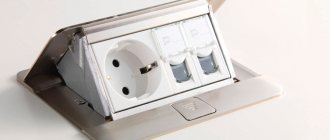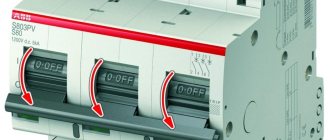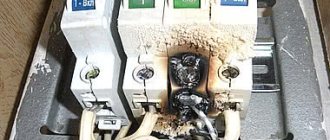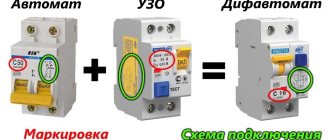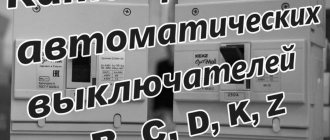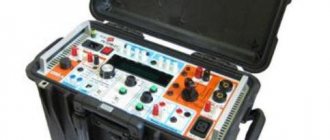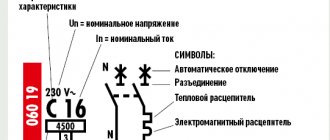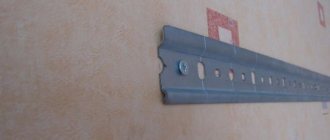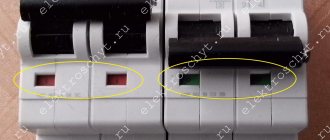Which machine is suitable for 15 kW
The purpose of a three-phase machine is protection against overloads.
The purpose of a 3-phase machine is protection against overcurrents and overloads. The 15 kW modification operates on a network with a voltage of 380 V, that is, you will need a 25 A device for input. When choosing, you need to take into account that in conditions of short circuits, the current strength increases and can cause a fire in the electrical wiring.
When selecting a 15 kW machine model for a three-phase load, you will need to take into account the parameters of the permissible voltage and current during a short circuit. It is worth focusing on the calculated current indicators of the cable with the minimum cross-section that protects the switch and the rated current of the receiver.
When calculating the input switching machine according to power parameters in a 380 V network, the following are taken into account:
- electrical power – actual and additional;
- cable loading intensity;
- availability of free capacity in the design indicator of a residential building;
- remoteness of outbuildings and non-residential premises from the cable entry point.
Cost of a 25A 380V machine
In a 15 kilowatt network with additional power, an ASU device is installed.
Design and principle of operation
Three-phase motor power calculation
The compact case contains the switching mechanism: two contacts, movable and fixed. When the cocking handle is moved to the working position, the contacts close and are mechanically fixed in the on state.
The circuit through which electric current flows includes two protective devices in series. One is triggered when the set threshold for temperature and current is exceeded (bimetallic plate), the second opens the contacts in the event of a short circuit, or rather, when the current value is significantly exceeded (electromagnetic release).
If the current gradually exceeds the permissible value (indicated on the marking of the machine), the plate heats up and mechanically opens the contacts. When a short circuit occurs, the current increases like an avalanche and activates the electromagnetic release. For multi-pole circuit breakers, it is enough to exceed the parameters on at least one line. The entire package of contacts will be disabled.
In all cases of protection activation, after the danger disappears, the circuit breaker does not return to its original state. A person is required to turn it on.
Functions of three-phase machines
Before choosing an automatic switch, you should understand its functionality. Users are often mistaken into thinking that the device protects household appliances. The machine does not respond to its electrical indicators, only triggering in the event of a short circuit or overload. The three-phase functions include:
- simultaneous maintenance of several single-phase circuit zones;
- preventing the formation of overcurrents on the line;
- joint work with AC rectifiers;
- protection of high-power equipment;
- increased power due to the installation of a special converter;
- fast response in short circuit mode on a line with a large number of consumers;
- the ability to turn off manually using a switch or switch;
- Compatible with optional safety terminals.
Without a automatic device, the risk of cable fire increases.
Operating principle and purpose of the circuit breaker
The three-phase circuit breaker is activated by an electromagnetic switch in case of line fault. The principle of operation of the element is to heat the bimetallic plate at the moment the current rating increases and the voltage is turned off.
The fuse prevents short circuits and overcurrents with values higher than the calculated values from affecting the wiring. Without it, the cable cores heat up to the melting point, which leads to the ignition of the insulating layer. For this reason, it is important to know whether the network can handle the voltage.
Correspondence of wires to load
The machines are selected according to the overall power of the equipment, but sometimes they do not work - the cable smokes or burns. For example, the cores of an old cable with a cross-section of 1.5 mm2 have a current limit of 19 A. If equipment with a total current of 22.7 A is turned on at a time, only a 25 Ampere modification will provide protection.
The wires will heat up, but the switch will remain turned on until the insulation melts. A fire can be prevented by completely replacing the wiring with a copper cable with a cross-section of 2.5 mm2.
Protecting the weakest section of cable wiring
Based on clause 3.1.4 of the PUE, the task of the automatic device is to prevent overload on the weakest link of the electrical circuit. Its rated current is selected based on the current of the connected household appliances.
If the machine is selected incorrectly, the unprotected area will cause a fire.
What is the machine used for?
A machine is installed in the power supply circuit to prevent overheating of the wiring. Any wiring is designed to carry a certain current. If the current passed exceeds this value, the conductor begins to heat up too much. If this situation persists for a sufficient period of time, the wiring begins to melt, resulting in a short circuit. A circuit breaker is installed to prevent this situation.
A packager or circuit breaker is necessary to prevent overheating of conductors and shutdown in the event of a short circuit
The second task of the circuit breaker is to turn off the power when a short circuit current (SC) occurs. When a short circuit occurs, the currents in the circuit increase many times over and can reach thousands of amperes. To prevent them from destroying the wiring and damaging the equipment included in the line, the circuit breaker must turn off the power as quickly as possible - as soon as the current exceeds a certain limit.
In order for the protective circuit breaker to properly perform its functions, it is necessary to correctly select the machine according to all parameters. There are not many of them - only three, but you need to deal with each one.
Principles for calculating the machine according to the cable cross-section
Calculations for a 3-phase automatic circuit breaker are carried out based on the cable cross-section. For a 25 A model, you will need to refer to the table.
| Wire cross-section, mm2 | Permissible load current based on cable material | |
| Copper | Aluminum | |
| 0,75 | 11 | 8 |
| 1 | 15 | 11 |
| 1,5 | 17 | 13 |
| 2,5 | 25 | 19 |
| 4 | 35 | 28 |
The 25 Ampere modification can be used to protect wiring or installed at the input.
For example, a copper wire with a cross-section of 1.5 mm2 with a permissible load current of 19 A is used for wiring. To prevent the cable from heating up, you will need to select a lower value - 16 A.
Cost of 16A machines
Determination of the dependence of power on the cross section using the formula
If the cable cross-section is unknown, you can use the formula:
Icalc=P/Unom, where:
- Icalc – calculated current,
- P – power of devices,
- Unom – voltage rating.
As an example, we can calculate the machine that will need to be installed on a boiler with a load of 3 kW and a network voltage of 220 V:
- Convert 3 kW to Watts – 3x1000=3000.
- Divide the value by the voltage: 3000/220=13.636.
- Round the calculated current to 14 A.
Depending on the environmental conditions and the method of laying the cable, you need to take into account the correction factor for the 220 V network. The average value is 5 A. It will need to be added to the calculated current indicator Icalc = 14 +5 = 19 A. Next, the cross-section of the copper wire is selected from the PUE table.
| Section, mm2 | Load current, A | |||||
| Single core cable | Two-core cable | Three-core cable | ||||
| Single wire | 2 wires together | 3 wires together | 4 wires together | Single installation | Single installation | |
| 1 | 17 | 16 | 15 | 14 | 15 | 14 |
| 1,5 | 23 | 19 | 17 | 16 | 18 | 15 |
| 2,5 | 30 | 27 | 25 | 25 | 25 | 21 |
| 4 | 41 | 38 | 35 | 30 | 32 | 27 |
| 6 | 50 | 46 | 42 | 40 | 40 | 34 |
You want to change the parameters of the input switch (if it is knocked out)
Three-phase network power calculation
One of the reasons is that your input circuit breaker is constantly knocked out at the same time as the internal circuit breaker in the distribution panel. And this didn’t happen before. Why is this happening? There are switches on the home panel with a similar maximum current value. For example, you had a 25 A ceramic fuse in your entrance (an old house). After repairs, it was replaced with a modern 20 A circuit breaker. And the distribution switches in the apartment have the same rating. It would seem easier to replace the machine at the entrance, and everything will fall into place. However, this is fraught with a fine from the energy supply company.
We will have to redo the home panel and install group circuit breakers with a lower value.
Selection of automatic switch by power
Calculating the total power of household appliances will help you choose a safety switch. You will need to look at the value in the device passport. For example, in the kitchen the following are plugged into the socket:
- coffee maker – 1000 W;
- electric oven – 2000 W;
- microwave oven – 2000 W;
- electric kettle – 1000 W;
- refrigerator – 500 W.
Summing up the indicators, we get 6500 W or 6.5 kilowatts. Next, you will need to refer to the table of machines depending on the connection power.
| Single-phase connection 220 V | Three-phase connection | Machine power | |
| Delta circuit 380 V | Star circuit, 220 V | ||
| 3.5 kW | 18.2 kW | 10.6 kW | 16 A |
| 4.4 kW | 22.8 kW | 13.2 kW | 20 A |
| 5.5 kW | 28.5 kW | 16.5 kW | 25 A |
| 7 kW | 36.5 kW | 21.1 kW | 32 A |
| 8.8 kW | 45.6 kW | 26.4 kW | 40 A |
Based on the standard voltage wiring table, you can select a 32 A device that is suitable for a total power of 7 kW.
Cost of a 32A machine
If you plan to connect additional equipment, an increase factor is used. The average value of 1.5 is multiplied by the power obtained from the calculations. A reduction factor is applied if it is impossible to operate several electrical appliances at the same time. It is equal to 1 or minus 1.
Summary table for selecting a circuit breaker for a three-phase 380 V network.
| Rated current of the circuit breaker, A. | Power, kWt. | Current, 1 phase 220V. | Cross-section of cable cores, mm2. |
| 16 | 0-7,9 | 0-15 | 1,5 |
| 25 | 8,3-12,7 | 15,8-24,1 | 2,5 |
| 32 | 13,1-16,3 | 24,9-31,0 | 4 |
| 40 | 16,7-20,3 | 31,8-38,6 | 6 |
| 50 | 20,7-25,5 | 39,4-48,5 | 10 |
| 63 | 25,9-32,3 | 49,2-61,4 | 16 |
| 80 | 32,7-40,3 | 62,2-76,6 | 25 |
| 100 | 40,7-50,3 | 77,4-95,6 | 35 |
| 125 | 50,7-64,7 | 96,4-123,0 | 50 |
| 160 | 65,1-81,1 | 123,8-124,2 | 70 |
| 200 | 81,5-102,7 | 155,0-195,3 | 95 |
| 250 | 103,1-127,9 | 196,0-243,2 | 120 |
| 315 | 128,3-163,1 | 244,0-310,1 | 185 |
| 400 | 163,5-207,1 | 310,9-393,8 | 2x95* |
| 500 | 207,5-259,1 | 394,5-492,7 | 2x120* |
| 630 | 260,1-327,1 | 494,6-622,0 | 2x185* |
| 800 | 328,1-416,1 | 623,9-791,2 | 3x150* |
* - double cable, two cables connected in parallel, for example 2 cables VVGng 5x120
Selecting a machine depending on the load power
For apartments and houses with new electrical wiring, the choice of machine is made based on the calculated load current.
A three-phase type device can be calculated by the rated load current or by the response speed in conditions of exceeding the current value. For calculations, you need to add up the power of all consumers and calculate the current passing through the line. Work is performed according to the formula:
I=P/U, where:
- P is the total power of all household appliances;
- U is the network voltage.
For example, the power is 7.2 kW, calculated using the formula 7200/220 = 32.72 A. The table shows ratings of 16, 20, 32, 25 and 40 A. The value is 32.72 A, taking into account the operation of the device at a value of 1 ,13 times more than the nominal value, multiply: 32x1.13=36.1 A. The table shows that it is better to install a 40 A model.
Selecting a circuit breaker and contactor based on engine power
Using the information from the table below, you can select a motor protection circuit breaker and a suitable contactor based on the power of a three-phase motor (or its rated current). Below the table are answers to the questions. The table shows the availability of products: green - in stock, blue - expected, gray - on order.
| Motor power 3~400V, kW | Setting range, A Imin – Inom | Instantaneous release current, A (circuit breaker) | Nom. off capacity, kA (circuit breaker) | Motor circuit breaker | Connection module | Contactor | DIN rail adapter |
| — | 0,10 – 0,16 | 2,1 | 100 | M4-32T-0.16 | M4 32 VK1 | K1-09D10 230 | — |
| 0,06 | 0,16 – 0,25 | 3,3 | 100 | M4-32T-0.25 | M4 32 VK1 | K1-09D10 230 | — |
| 0,09 | 0,25 – 0,4 | 5,2 | 100 | M4-32T-0.4 | M4 32 VK1 | K1-09D10 230 | — |
| 0,18 | 0,4 – 0,63 | 8,2 | 100 | M4-32T-0.63 | M4 32 VK1 | K1-09D10 230 | — |
| 0,25 | 0,63 – 1 | 13 | 100 | M4-32T-1 | M4 32 VK1 | K1-09D10 230 | — |
| 0,55 | 1,0 – 1,6 | 20,8 | 100 | M4-32T-1.6 | M4 32 VK1 | K1-09D10 230 | — |
| 0,75 | 1,6 – 2,5 | 32,5 | 100 | M4-32T-2.5 | M4 32 VK1 | K1-09D10 230 | — |
| 1,5 | 2,5 – 4 | 52 | 100 | M4-32T-4 | M4 32 VK1 | K1-09D10 230 | — |
| 2,2 | 4 – 6 | 78 | 100 | M4-32T-6 | M4 32 VK1 | K1-09D10 230 | — |
| 3 | 5 – 8 | 104 | 100 | M4-32T-8 | M4 32 VK1 | K1-09D10 230 | — |
| 4 | 6 – 10 | 130 | 50 | M4-32T-10 | M4 32 VK1 | K1-09D10 230 | — |
| 5,5 | 9 – 13 | 169 | 50 | M4-32T-13 | M4 32 VK1 | K1-12D10 230 | — |
| 7,5 | 11 – 17 | 221 | 20 | M4-32T-17 | M4 32 VK3 | K3-18ND10 230 | — |
| 7,5 | 14 – 22 | 286 | 15 | M4-32T-22 | M4 32 VK3 | K3-22ND10 230 | — |
| 11 | 18 – 26 | 338 | 15 | M4-32T-26 | M4 32 VK3 | K3-22ND10 230 | — |
| 15 | 22 – 32 | 416 | 15 | M4-32T-32 | M4 32 VD | K3-32A00 230 | M4 32 HU1 |
| — | 0,10 – 0,16 | 2,1 | 100 | M4-32R-0.16 | M4 32 VK3 | K3-10ND10 230 | — |
| 0,06 | 0,16 – 0,25 | 3,3 | 100 | M4-32R-0.25 | M4 32 VK3 | K3-10ND10 230 | — |
| 0,09 | 0,25 – 0,4 | 5,2 | 100 | M4-32R-0.4 | M4 32 VK3 | K3-10ND10 230 | — |
| 0,18 | 0,4 – 0,63 | 8,2 | 100 | M4-32R-0.63 | M4 32 VK3 | K3-10ND10 230 | — |
| 0,25 | 0,63 – 1 | 13 | 100 | M4-32R-1 | M4 32 VK3 | K3-10ND10 230 | — |
| 0,55 | 1,0 – 1,6 | 20,8 | 100 | M4-32R-1.6 | M4 32 VK3 | K3-10ND10 230 | — |
| 0,75 | 1,6 – 2,5 | 32,5 | 100 | M4-32R-2.5 | M4 32 VK3 | K3-10ND10 230 | — |
| 1,5 | 2,5 – 4 | 52 | 100 | M4-32R-4 | M4 32 VK3 | K3-10ND10 230 | — |
| 2,2 | 4 – 6 | 78 | 100 | M4-32R-6 | M4 32 VK3 | K3-10ND10 230 | — |
| 3 | 5 – 8 | 104 | 100 | M4-32R-8 | M4 32 VK3 | K3-10ND10 230 | — |
| 4 | 6 – 10 | 130 | 100 | M4-32R-10 | M4 32 VK3 | K3-10ND10 230 | — |
| 5,5 | 9 – 13 | 169 | 100 | M4-32R-13 | M4 32 VK3 | K3-14ND10 230 | — |
| 7,5 | 11 – 17 | 221 | 50 | M4-32R-17 | M4 32 VK3 | K3-18ND10 230 | — |
| 7,5 | 14 – 22 | 286 | 50 | M4-32R-22 | M4 32 VK3 | K3-22ND10 230 | — |
| 11 | 18 – 26 | 338 | 50 | M4-32R-26 | M4 32 VK3 | K3-22ND10 230 | — |
| 15 | 22 – 32 | 416 | 50 | M4-32R-32 | M4 32 VD | K3-32A00 230 | M4 32 HU1 |
| 12,5 | 18 – 26 | 338 | 50 | M4-63R-26 | M4 63 VD | K3-32A00 230 | M4 63 HU1 |
| 15 | 22 – 32 | 416 | 50 | M4-63R-32 | M4 63 VD | K3-32A00 230 | M4 63 HU1 |
| 18,5 | 28 – 40 | 520 | 50 | M4-63R-40 | M4 63 VD | K3-40A00 230 | M4 63 HU1 |
| 22 | 34 – 50 | 650 | 50 | M4-63R-50 | M4 63 VD | K3-50A00 230 | M4 63 HU1 |
| 30 | 45 – 63 | 819 | 50 | M4-63R-63 | M4 63 VD | K3-62A00 230 | M4 63 HU1 |
| 30 | 45 – 63 | 819 | 50 | M4-100R-63 | M4 100 VD | K3-62A00 230 | M4 100 HU1 |
| 37 | 55 – 75 | 975 | 50 | M4-100R-75 | M4 100 VD | K3-74A00 230 | M4 100 HU1 |
| 45 | 70 – 90 | 1170 | 50 | M4-100R-90 | K3-90A00 230 | — | |
| — | 80 – 100 | 1300 | 50 | M4-100R-100 | K3-115A00 230 | — |
How to select a circuit breaker to protect an electric motor:
1. The rated current of the circuit breaker must be greater than or equal to the rated current of the motor.
2. The starting current of the electric motor is usually 7 times higher than the rated current (the exact value for a specific motor is indicated in the passport). Because The circuit breaker should not trip when starting the engine; you must make sure that the value in the column “Instantaneous trip current during short circuit” with some margin it will be higher than the starting current. The starting current for these voltages is calculated by the formula Inom*KRATH*COEF
, where
Inom
is the rated current of the electric motor,
KRATH
is the multiple of the starting current of the electric motor,
COEF
is a correction factor that takes into account the deviation of the starting current from the rated current, voltage fluctuations (taken equal to 1.4).
3. The rated current of the automatic switch must be less than the maximum permissible current of the cable that connects the electric motor. Example
: let's take an AIR90L4 motor with a power of 2.2 kW, the passport indicates: rated current In (delta/star) (220/380V) = 8.91A / 5.16A;
multiplicity of starting current Iп/In=6.8. Based on the rated current of the electric motor (5.16A), we select the motor protection circuit breaker M4-32T-6
with a rated current of
6A
.
We check: the starting current 5.16 * 6.8 * 1.4 = 49.12 A
does not exceed the “Instantaneous trip current during short circuit”
equal to 78A
. THAT. the machine will not operate when the engine starts. Therefore, this circuit breaker is suitable for protecting the said motor.
Questions and answers:
Q: In what cases does the motor protection circuit breaker trip?
A: M4 circuit breakers are equipped with: 1. a bimetallic thermal circuit breaker, which operates depending on the setting for the rated current of the motor (the setting is set by the regulator on the front panel), this circuit breaker is inertial and operates faster, the higher the current.
2. an instantaneous electromagnetic circuit breaker that is triggered in the event of a short circuit; the response threshold is 13 times higher than the rating of the circuit breaker and therefore eliminates false triggering when starting the electric motor. Q: What is the difference between M4-32T.. and M4-32R.. circuit breakers?
T
circuit breakers have a push-button activation mechanism, while M4-32
R
circuit breakers are equipped with a rotary switch.
Q: What operating conditions are M4 motor circuit breakers designed for?
M4 circuit breakers are suitable for any climate.
To avoid false alarms, it is recommended to avoid blowing fresh or cold air (from the air conditioning system) onto the machines. M4 circuit breakers are designed to operate in enclosed spaces under normal conditions (i.e. without dust, corrosive vapors or harmful gases). In case of use in rooms with conditions other than normal operating conditions, it is necessary to use an IP65 protective housing, for example M4 32R PFH4
(gray) or
M4 32R PFHN4
(yellow-red).
Q: Where can I find information on accessories for M4 motor protection circuit breakers?
A: See the section ACCESSORIES FOR BENEDICT AUTOMATIC MOTORS?
(additional contact blocks, alarm contacts, undervoltage release, independent release, jumpers, etc.) Q: What specific value should the motor protection circuit breaker be set to?
A: The setting of the circuit breaker must be set to the value of the rated operating current of the electric motor indicated on the nameplate (in the passport).
Q: Is it possible to use M4 motor circuit breakers for single-phase electric motors?
A: Yes, it's possible.
In this case, the connection should be made as shown in the figure: Q: What protection do M4 circuit breakers provide? 1. Protection in the event of short circuit currents.
In the event of a short circuit in the load, the instantaneous release ensures that the load is disconnected from the power supply, thus preventing additional damage from the action of high currents.
M4 circuit breakers have a breaking capacity of 50kA and 100kA, which at voltages of 380-400V AC is completely reliable protection, because Higher currents cannot normally occur at the point where this equipment is installed. In general, the use of fuses is not required, but additional fuses can be installed in cases where the short circuit current at the equipment installation point may exceed the rated breaking capacity of the circuit breaker. 2. Engine protection.
The tripping characteristics of M4 circuit breakers are specially designed for the protection of three-phase electric motors.
Therefore, circuit breakers for protecting electric motors can also be called manual motor starters. The rated current of the protected motor is selected by the regulator on the front panel of the device. 3. Network protection.
M4 motor circuit breakers also provide network protection.
They comply with the requirements of GOST IEC 60947-3-2016 (Switches, disconnectors, switch-disconnectors and their combinations with fuses) and GOST IEC 60947-2-2014 (Low-voltage distribution and control equipment). In accordance with GOST R IEC 60204-1-2007, these circuit breakers can be used as a main or emergency switch (please note that insulation requirements are not met when using a door joint accessory). Tripping characteristics of M4 circuit breakers for motor protection:
II - The curve shows the characteristic of the instantaneous electromagnetic trip (short-circuit trip) Information on accessories for M4 motor circuit breakers
Methods for selecting a difavtomat
For example, consider a kitchen where a large amount of equipment is connected. First, you need to set the total power rating for a room with a refrigerator (500 W), microwave (1000 W), kettle (1500 W) and hood (100 W). The total power indicator is 3.1 kW. Based on it, various methods are used to select a 3-phase machine.
Table method
Based on the device table, a single-phase or three-phase device is selected based on the connection power. But the value in the calculations may not coincide with the tabular data. For a 3.1 kW network section, you will need a 16 A model - the closest value is 3.5 kW.
Graphical method
The selection technology is no different from the tabular one - you will need to find a schedule on the Internet. In the figure, the switches with their current load are shown horizontally, and the power consumption in one section of the circuit is shown vertically.
To establish the power of the device, you will need to draw a line horizontally to the point with the rated current. A total network load of 3.1 kW corresponds to a 16 A switch.
How to choose a machine based on current strength
We already know that all the electrical current to power the object will flow through this switch. According to Ohm's law, it is clear that the load must be summed up based on all consumers in the house (apartment). Calculating this value is quite simple.
Of course, you can turn on the boiler, electric oven, air conditioner and iron at the same time. But such a “celebration of life” will require powerful electrical wiring. And the technical conditions for such input power will cost significantly more. For energy supply organizations, tariffs for coordinating connections grow linearly depending on the number of kilowatts.
For a typical apartment, we can assume the simultaneous operation of a refrigerator, TV, computer, and air conditioner. In addition to them, it is permissible to turn on one of the powerful appliances: a boiler, an oven or an iron. That is, the total power of electrical appliances will not exceed 3 kW. We don’t take lighting into account; today, every home has energy-saving lamps.
Usually, for a power reserve (force majeure circumstances are possible), 20–30% is added to the calculations. If you forget to turn off the boiler and start using the iron while the air conditioner is running, you won’t have to run to the electrical panel to restore the power supply. It turns out: 4 kW divided by 220 V (according to Ohm’s law), current consumption 18 A. The nearest circuit breaker is rated 20 A.
The marking is in the product passport, and always on the body.
When selecting a device more accurately, especially when used in conjunction with a non-standard load (motors or other loads with significant starting currents), it is necessary to make a choice not only by the rated current, but also by the time-current characteristic.
For example, the input circuit breaker shown below in the picture has a rated current of 16A and a characteristic of type “C” (type “C” is well suited for the usual standard load - our apartments).
We will tell you more about the time-current characteristic below.
We are not interested in higher currents, this exceeds the power of 15 kW. No one will approve such a connection to your apartment. Typically, residential input is limited to automatic machines with an operating window of about 32 A.
For a private home, the figures may be higher. The calculation takes into account the increased living space, the presence of outbuildings with power supply, a garage, a workshop, and powerful power tools. An input circuit breaker for supplying power to a private house usually has an operating current of 50 A or 63 A.
Criteria for selecting a three-phase switch
Before purchasing, it is worth considering all the parameters that the input device will have.
Phase and voltage
Single-phase 220 V models are connected to one terminal, three-phase 380 V models are connected to three.
Leakage current
The body is marked with the Greek letter “delta”. The current leakage of a private house is about 350 mA, of a separate group of devices - 30 mA, lamps and sockets - 30 mA, single links - 15 mA, boiler - 10 mA.
Varieties by current
The machine has indexes A (triggered by DC leakage) and AC (triggered by AC leakage).
Number of poles
Depending on the number of poles, you can purchase a three-phase switch:
- single-pole type of devices for protecting one cable and one phase;
- two-pole, represented by two devices with a common switch - switching off occurs when the permissible value of one of them is exceeded, at the same time the neutral and phase in a single-phase network are cut off;
- a three-pole device that provides interruption and protection of the phase circuit - they are three devices with a common activation/deactivation handle;
- a four-pole device, which is mounted only on the input of a three-phase switchgear, breaks all three phases and the working zero. Breaking the grounding of the protection is unacceptable.
Regardless of the number of poles, the device shutdown time should not exceed 0.3 seconds.
Installation location
For domestic use, a 3-phase electric circuit breaker marked C is intended for 25 A. In this case, it is better to install products C50, C65, C85, C95 at the input. For sockets or other points - C 25 and C 15, for lighting - C 12 or C 17, for an electric stove - C 40. They will operate when the current readings are 5-10 times higher than the nominal value.
Automatic switches for household networks
Electricity supply organizations connect houses and apartments by carrying out work on connecting the cable to the switchboard. All installations of wiring in the premises are carried out by its owners or hired specialists.
To select a circuit breaker to protect each individual circuit, you need to know its rating, class and some other characteristics.
Basic parameters and classification
Household machines are installed at the entrance to a low-voltage electrical circuit and are designed to solve the following problems:
- manual or electronic activation or de-energization of an electrical circuit;
- circuit protection: current cut-off during minor long-term overload;
- Circuit protection: instantaneous shutdown of current in case of short circuit.
Each switch has a characteristic, expressed in amperes, which is called rated current (In) or "rating".
The essence of this value is easier to understand using the coefficient of excess of the nominal value:
K=I/In,
where I is the actual current strength.
- K < 1.13: tripping will not occur within 1 hour;
- K > 1.45: shutdown will occur within 1 hour.
These parameters are fixed in clause 8.6.2. GOST R 50345-2010. To find out how long it will take for a shutdown to occur at K>1.45, you need to use a graph reflecting the time-current characteristic of a specific machine model.
If the current exceeds the rated value of the switch by 2 times for a long time, the opening will occur within a period of 8 seconds to 4 minutes. The response speed depends on the model settings and the ambient temperature
Also, each type of circuit breaker has a current range (Ia) at which the instantaneous tripping mechanism is triggered:
- class "B": Ia = (3 * In .. 5 * In];
- class "C": Ia = (5 * In .. 10 * In];
- class "D": Ia = (10 * In .. 20 * In].
Type “B” devices are used mainly for lines that are of considerable length. In residential and office premises, class “C” circuit breakers are used, and devices marked “D” protect circuits where there is equipment with a high starting current coefficient.
The standard line of household machines includes devices with ratings of 6, 8, 10, 16, 20, 25, 32, 40, 50 and 63 A.
Structural design of releases
There are two types of releases in a modern circuit breaker: thermal and electromagnetic.
A bimetallic release has the shape of a plate created from two conductive metals with different thermal expansion. This design, when exceeding the nominal value for a long time, leads to heating of the part, its bending and the activation of the circuit breaking mechanism.
For some machines, you can use the adjusting screw to change the parameters of the current at which the shutdown occurs. In the past, this technique was often used to “fine-tune” a device, but this procedure requires in-depth specialized knowledge and several tests.
By rotating the adjusting screw (highlighted with a red rectangle) counterclockwise, you can achieve a longer response time for the thermal release
Now on the market you can find many models of standard ratings from different manufacturers, whose time-current characteristics are slightly different (but at the same time comply with regulatory requirements). Therefore, it is possible to select a machine with the required “factory” settings, which eliminates the risk of incorrect calibration.
The electromagnetic release prevents overheating of the line as a result of a short circuit. It reacts almost instantly, but the current value must be several times higher than the nominal value. Structurally, this part is a solenoid. The overcurrent generates a magnetic field that moves the core, breaking the circuit.
Compliance with selectivity principles
If there is a branched electrical circuit, it is possible to organize protection in such a way that in the event of a short circuit, only the branch on which the emergency situation occurs is disconnected. For this purpose, the principle of switch selectivity is used.
A visual diagram showing the principle of operation of a circuit breaker system with an implemented function of selectivity (selectivity) of operation when a short circuit occurs
To ensure selective shutdown, instantaneous cutoff circuit breakers are installed at the lower stages, breaking the circuit in 0.02 - 0.2 seconds. The switch located at a higher stage either has an operation delay of 0.25 - 0.6 s or is made according to a special “selective” circuit in accordance with the DIN VDE 0641-21 standard.
To ensure selective operation of the machines, it is better to use machines from one manufacturer. For switches of a single model range, there are selectivity tables that indicate possible combinations.
The simplest installation rules
The section of the circuit that needs to be protected by a switch can be single- or three-phase, have a neutral, as well as a PE (ground) wire. Therefore, the machines have from 1 to 4 poles, to which the conductor is connected. When conditions for tripping are created, all contacts are disconnected simultaneously.
The machines in the panel are mounted on a specially designated DIN rail. It provides compact and safe connection, as well as convenient access to the switch
The machines are installed as follows:
- single-pole per phase;
- bipolar for phase and neutral;
- three-pole for 3 phases;
- four-pole for 3 phases and neutral.
However, it is prohibited to do the following:
- install single-pole circuit breakers to neutral;
- insert PE wire into the machine;
- install three single-pole ones instead of one three-pole circuit breaker, if at least one three-phase consumer is connected to the circuit.
All these requirements are specified in the PUE and must be followed.
In every house or room to which electricity is supplied, an introductory machine is installed. Its nominal value is determined by the supplier and this value is specified in the electricity connection agreement. The purpose of such a switch is to protect the area from the transformer to the consumer.
After the input circuit breaker, a meter (single- or three-phase) and a residual current device are connected to the line, the functions of which differ from the operation of an automatic and differential switch.
If the room is wired into several circuits, then each of them is protected by a separate circuit breaker, the power of which is indicated in the marking. Their ratings and classes are determined by the owner of the premises, taking into account the existing wiring or power of connected devices.
The electricity meter and circuit breakers are installed in a distribution board that meets all safety requirements and can easily be integrated into the interior of the room
When choosing a location for the distribution board, it must be remembered that the properties of the thermal release are affected by air temperature. Therefore, it is advisable to place the rail with machines inside the room itself.
Nuances to consider
no one can know exactly what household appliances will be in a house or apartment. For this reason you should:
- increase the total calculated power of a three-phase automatic circuit breaker by 50%, or apply an increase factor of 1.5;
- a reduction factor is taken into account when there are not enough sockets in the room to simultaneously connect equipment;
- to simplify calculations, the load should be divided into groups;
- powerful devices should be connected separately, taking into account the low-power load;
- to calculate a low-power load, you will need to divide the power by the voltage;
- wiring is the main factor that is taken into account when choosing a 3-phase automatic switch; old aluminum wires can withstand 10 A, but if taken for 16 A sockets, they can melt;
- in domestic conditions, models with current ratings of 6, 16, 25, 32 and 40 A are most often used.
When purchasing a three-phase differential circuit breaker, you need to take into account that the main markings are on the case or in the passport. Using formulas and tables will help you choose a model in accordance with the wiring in the apartment and the power of household appliances.
Calculator for calculating circuit breaker current.
Using the power calculator, you can independently calculate power by current and voltage for single-phase (220 V) and three-phase networks (380 V). The cos φ value is taken according to the instructions in the technical data sheet of the device, the average values of the tables below, or calculated independently using formulas. We recommend not changing the coefficient unless necessary and leaving it at 0.95. To get the calculation result, click the “Calculate” button.
Calculation of cosine phi (cos φ) φ is the shift angle between the phase of current and voltage, and if the latter leads the current, the shift is considered positive, if it lags, it is negative. cos φ is a dimensionless quantity that is equal to the ratio of active power to total power and shows how efficiently energy is used.
Formula for calculating cosine phi: cos φ = S / P
S – total power, VA (Volt-ampere); P – active power, W. Active power (P) is the real, useful, real power, this load absorbs all the energy and turns it into useful work, such as light from a light bulb. There is no phase shift.
Formula for calculating active power: P (W) = I × U × cos φ
Reactive power (Q) is watt-free (useless) power, which is characterized by the fact that it does not participate in work, but is transmitted back to the source. The presence of a reactive component is considered a detrimental characteristic of a circuit, since the main purpose of the existing power supply is to reduce costs, and not to pump it back and forth. This effect is created by coils and capacitors.
Formula for calculating reactive power: P (VAR) = I × U × sin φ
The total power of an electrical appliance (S) is a total value that includes both active and reactive components of power.
Formula for calculating apparent power: S (VA) = I × U or S = √( P2 + Q2)
*Approximate power factor values are presented in the table:
| Household electrical appliances | Power, W | cos φ |
| Electric stove | 1200 — 6000 | 1 |
| Heater | 500 — 2000 | 1 |
| Vacuum cleaner | 500-2000 | 0,9 |
| Iron | 1000 — 2000 | 1 |
| Hairdryer | 600 — 2000 | 1 |
| TV | 100 — 400 | 1 |
| Fridge | 150 — 600 | 0,95 |
| Microwave | 700 — 2000 | 1 |
| Electric kettle | 1500 — 2000 | 1 |
| Incandescent lamps | 60 — 250 | 1 |
| Fluorescent lamps | 20 — 400 | 0,95 |
| Boiler | 1500 — 2000 | 1 |
| Computer | 350 — 700 | 0,95 |
| Coffee maker | 650 — 1500 | 1 |
| Washing machine | 1500 — 2500 | 0,9 |
| Power tools | Power, W | cos φ |
| Electric drill | 400 — 1000 | 0,85 |
| Bulgarian | 600 — 3000 | 0,8 |
| Hammer | 500 — 1200 | 0,85 |
| Compressor | 700 — 2500 | 0,7 |
| Electric motors | 250 — 3000 | 0,7 — 0,8 |
| Vacuum pump | 1000 — 2500 | 0,85 |
| Electric welding (arc) | 1800 — 2500 | 0,3 — 0,6 |
IMPORTANT! Remember that to protect the household electrical network it is necessary to use circuit breakers with a “C” response characteristic, and to protect electric motors - with a “D” response characteristic.

